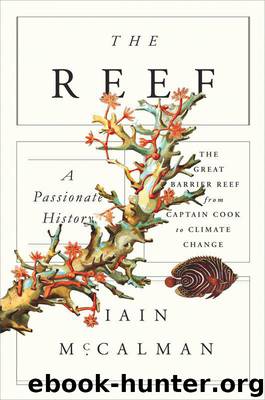The Reef: A Passionate History: The Great Barrier Reef from Captain Cook to Climate Change by McCalman Iain

Author:McCalman, Iain [McCalman, Iain]
Language: eng
Format: epub, mobi
ISBN: 9780374711702
Publisher: Farrar, Straus and Giroux
Published: 2014-05-19T21:00:00+00:00
PART THREE
Wonder
9
OBSESSION
The Quest to Prove the Origins of the Reef
PEOPLE WHO KNEW American zoologist Alex Agassiz described him as a kindly, gentle, and eminently rational man, yet he spent much of the latter part of his life engaged in what appears to have been an obsessive, expensive, and quixotic quest to visit and analyze all the coral reefs of the world. His epic series of Pacific and Indian ocean voyages began on April 16, 1896, with an expedition to the greatest reef of all.
Agassiz was already sixty-one when he embarked on the small chartered steamer the Croydon from Brisbane. One of his assistants on that trip, Alfred Mayor, recorded that during the next twenty-five years, Agassiz would “wander further and see more coral reefs than has any man of science of the present or past.”1
Alex Agassiz’s aim was ambitious: he wanted to discredit Charles Darwin’s famous theory of the origin of coral reefs, and where better to start than Australia. His Croydon expedition marks yet another change in the perception of the Great Barrier Reef, which, having experienced varied shades of fame and infamy, was catapulted by Agassiz’s quest to global scientific prominence. The Reef became a centerpiece in a fierce debate among the world’s leading geologists, marine scientists, and oceanographers—a debate that was as important internationally as it was in Australia.
Why, though, should an aging and reclusive expert on starfish like Agassiz choose this moment to mount such an obsessive mission to the other side of the globe? It was equally odd for Charles Darwin’s theory of coral reefs to be generating such heated debate so long after its first drafting. After all, this had been Darwin’s juvenile scientific achievement, scribbled sixty years earlier when voyaging around the world as a young gentleman’s companion on the HMS Beagle. He confessed that the theory had been an act of pure deduction, having come to him when he was scrambling up the Andes Mountains in Chile, before he’d ever seen a coral reef. Coral fossils within the Andes rock strata suggested to Darwin that this vast mountain chain had been elevated gradually from the ocean floor by volcanic action over aeons of time.
But what goes up can also go down: perhaps, thought Darwin, a corresponding subsidence had taken place on the bed of the Pacific and Indian oceans? This would explain a mystery long puzzling to navigators and naturalists: how these tiny coral “insects,” known to live only in shallow, light-filled waters, had built vast ramparts that rose up from the dark depths of the oceans.
If, speculated Darwin, coral reefs grew in a ring pattern around the shallow fringes of volcanic pinnacles in the sea, and if these rocky islets were to subside at a pace that matched the reefs’ upward growth, they would create thick walls of dead coral with a living crust on top. Over many centuries this process would leave behind circular atolls surrounding shallow lagoons, or barrier reefs separated from the mainland by lagoon-like channels.
Charles Darwin’s few
Download
The Reef: A Passionate History: The Great Barrier Reef from Captain Cook to Climate Change by McCalman Iain.mobi
This site does not store any files on its server. We only index and link to content provided by other sites. Please contact the content providers to delete copyright contents if any and email us, we'll remove relevant links or contents immediately.
| Cell Biology | Developmental Biology |
| Entomology | Marine Biology |
| Microbiology | Molecular Biology |
| Biostatistics |
Sapiens: A Brief History of Humankind by Yuval Noah Harari(14245)
The Tidewater Tales by John Barth(12608)
Mastermind: How to Think Like Sherlock Holmes by Maria Konnikova(7223)
Do No Harm Stories of Life, Death and Brain Surgery by Henry Marsh(6887)
The Thirst by Nesbo Jo(6826)
Why We Sleep: Unlocking the Power of Sleep and Dreams by Matthew Walker(6618)
Life 3.0: Being Human in the Age of Artificial Intelligence by Tegmark Max(5474)
Sapiens by Yuval Noah Harari(5293)
The Longevity Diet by Valter Longo(5017)
The Body: A Guide for Occupants by Bill Bryson(4973)
The Rules Do Not Apply by Ariel Levy(4845)
The Immortal Life of Henrietta Lacks by Rebecca Skloot(4525)
Animal Frequency by Melissa Alvarez(4394)
Why We Sleep by Matthew Walker(4358)
The Hacking of the American Mind by Robert H. Lustig(4318)
Yoga Anatomy by Kaminoff Leslie(4303)
All Creatures Great and Small by James Herriot(4230)
Double Down (Diary of a Wimpy Kid Book 11) by Jeff Kinney(4204)
Barron's AP Biology by Goldberg M.S. Deborah T(4095)
